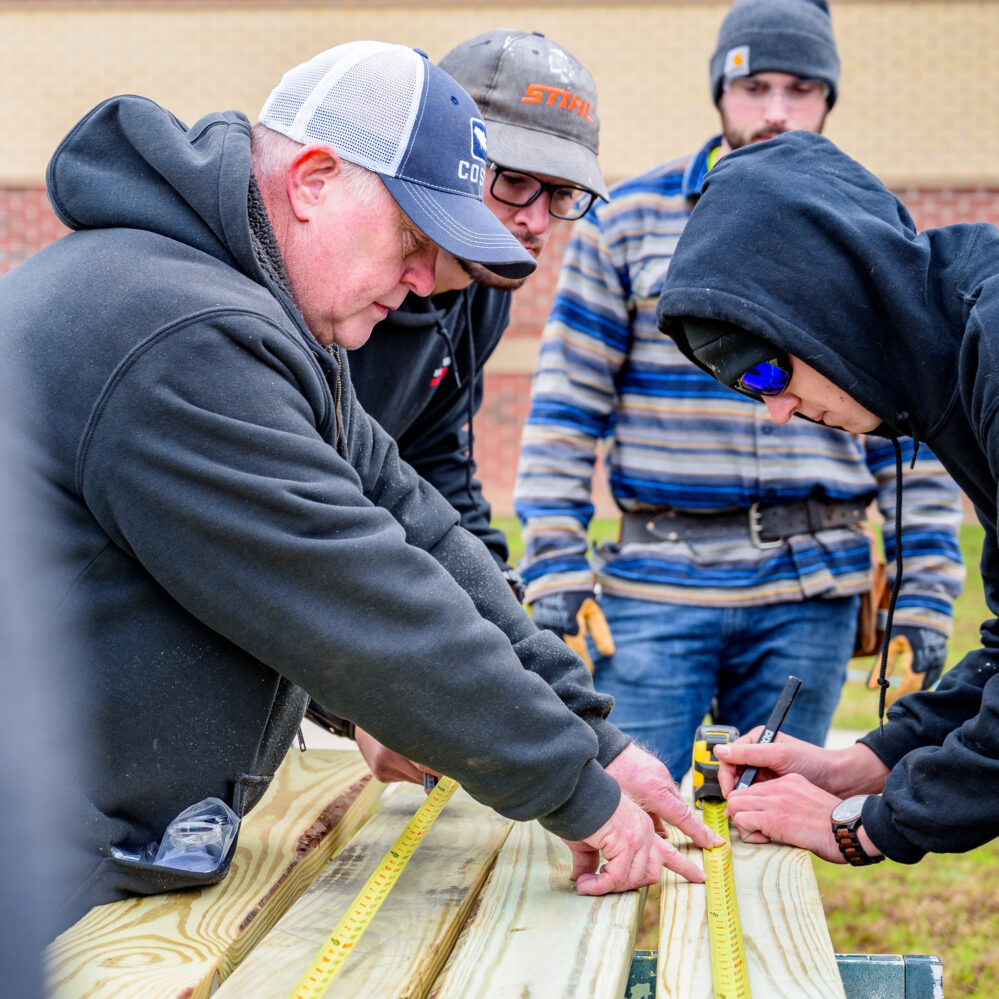Service-to-Career Pathways: A Playbook for State Service Commissions to Create Economic Opportunity
Next100 alum Robert Godfried presents a comprehensive toolkit for how the agencies that administer AmeriCorps funds can make public service the economic launchpad it deserves to be.

Acknowledgement

This project was made possible by the generous support of the Schultz Family Foundation and completed in partnership with America’s Service Commissions.
Purpose of This Playbook
“National service done right can and should be a pathway to work, wages, and wealth and an antidote to the isolationism and individualism that is plaguing our country.”—Governor Wes Moore
The call to serve can bring people from different backgrounds together to address needs in their communities. A year of service can also build a pathway to economic opportunity for the members who serve, by providing new skills, experiences, and extended social capital that can translate to new career opportunities and networks.
State and territorial service commissions, the state-level agencies or nonprofits that administer AmeriCorps funds and other service initiatives, have a unique opportunity to drive forward innovations in building pathways to economic opportunity through service by creating collaborative approaches across national service, workforce, and educational partners in their states. Additionally, state service commissions are uniquely positioned to influence national service grantmaking priorities and locally led service programming while holding knowledge of the local needs and workforce shortages to align state and federal efforts around service-to-career pathways.
Next100, the Schultz Family Foundation, and America’s Service Commissions (ASC) created this playbook as a how-to guide for governors, state service commissions, state agencies, and workforce development boards seeking to put into action lessons from the National Governors Association’s “Service As A Pathway To Economic Opportunity: A Roadmap For Governors.” This playbook is based on the belief that service programs have the potential to address workforce shortages, meet community needs, and provide service-to-career pathways that create economic mobility opportunities for members. That potential is best realized when efforts are built in partnership with public, private, and philanthropic stakeholders, adding new resources to further the impact of their work on communities and members.
How to Use This Playbook
This playbook outlines an aspirational vision for how governors, state service commissions, state agencies, and workforce development boards can create and move national service programs across a continuum that embraces workforce development effective practices to serve as career pathway programs that are responsive to state needs while increasing member living allowances, benefits, and economic opportunities. These parties can leverage federal funding from AmeriCorps (the largest source of funding for national service in the country), foster interagency state-level partnerships, collaborate with local stakeholders, and embrace braided funding streams.
The categories described below correspond with an accompanying worksheet for state service commissions to self-evaluate their practices on a scale of 1 to 5 (with 1 standing for needing improvement, and 5 standing for exemplary execution). Successful use of this playbook and worksheet involves experimenting with and modifying the relevant effective practices to fit state needs and priorities, rather than attempting to comply with every listed action item without consideration of local and regional contexts. The steps within each of these categories should be viewed as a sequential set of steps, with success defined by completing the bullets that make sense for the commission, rather than striving for 100-percent completion.
This playbook focuses on three categories:
- Economic Opportunity: How to maximize the economic opportunities cultivated during service that support members in seeking a job post-service that supports a path to upward mobility, which can include entering higher education, industry-hosted apprenticeship programs, and/or a career pathway.
- Accessibility: How to increase the accessibility of national service programs to allow individuals with diverse backgrounds (e.g., racial, economic, geographic, educational attainment, viewpoints, etc.) to participate in a term of service.
- State Service Commission Capacity: How to augment state service commission capacity to broaden the accessibility and economic opportunities of national service positions in their state, while also being responsive to state and community needs.
Each focus area offers a range of priorities and actions that state service commissions can take, regardless of their experience in designing new state-led initiatives in partnership with AmeriCorps programs, service year programs and workforce stakeholders.
A Note on Member Benefits
The AmeriCorps agency sets a minimum and maximum living allowance that applies to full-time (1,700 hours per year) AmeriCorps State and National positions. All full-time positions are required to provide at least the minimum living allowance. In addition, recent AmeriCorps agency guidance has confirmed that offering a housing stipend or additional benefits does not count towards the maximum living allowance. Less-than-full-time AmeriCorps State and National positions are not required to provide a living allowance, but if they do, they must follow the corresponding minimum and maximums per slot type.
National service member compensation, benefits, and training can be augmented by seeking out additional state and philanthropic funds and by leveraging partnerships with state agencies. State service commissions have the unique ability to act as a representative for national service programs across a state or territory, allowing them to raise or accept philanthropic funds state-wide and build partnerships with local and regional employers. Commissions can also use their state-wide partnerships to access funders and employers that may be inaccessible to smaller or less-well-known grantee programs. For example, California Volunteers—the California state service commission—recently raised the living allowance for all AmeriCorps State and National service members to $30,000 per year, the equivalent of $17.65 per hour. In addition, all members who complete their service also receive an education award of up to $10,000, with the state augmenting the Segal AmeriCorps Education Award (indexed to the value of the federal Pell Grant) that members receive from the federal agency.
 I. Economic Opportunity
I. Economic Opportunity
Governors, state agencies, and workforce boards have the opportunity to work with their state service commission and AmeriCorps to leverage national service programming as a career development pathway aligned with state workforce needs that expand post-service opportunities for corps members.
Many of the most successful efforts to leverage service and workforce development have been the product of partnerships, some begun by the governor’s office, others begun by the state service commission or other state agencies. These partnerships built on shared goals and leveraged funding streams, resulting in national service programming offering career development pathways aligned with state workforce needs that expand post-service opportunities for corps members. The economic impact of service on state and local economies is further increased if the members impacted are from the communities served. However, for service programs to adequately prepare members for post-service upwardly mobile careers, state service commissions must be positioned to take the lead on building relationships with the governor’s office, state-level departments (e.g. department of labor, department of workforce development, department of energy, etc.), and regional workforce development boards to understand the state’s workforce needs and to create effective industry-responsive workforce development training for members.
State service commissions should work to build relationships with major employers and industry partners in the state to better understand the workforce challenges they face and the skills they are seeking in potential employees. Lastly, commissions should build relationships with philanthropic organizations to understand their funding interests and how they can align with service programming in the state.
The guidelines offered below outline how state service commissions can move towards these priorities to increase economic opportunity for members after their term of service.
1. Invest in Workforce Development Training and Member Career Development as Part of a Term of Service
- Prioritize the development of service-to-career pathways that create economic mobility opportunities for members in the state service plan
- Integrate accessibility and economic opportunity into the state service plan by taking steps to:
- Solicit feedback from partner agencies, grantees, members, and other relevant parties on the state service plan and incorporate this feedback into the document
- Indicate to commissioners, staff, grantees, host sites, and potential partners that these goals are a priority for the commission
- Share the final service plan in detail with grantees, state agencies, and the governor’s office to ensure alignment on key goals
- Set up follow-up meetings with these offices to discuss potential partnerships based on alignment of shared goals
- Increase investment in grantees that incorporate workforce development training and support members in building career development, including ones that:
- Align service opportunities with community needs and in-demand careers that pay a living wage
- Embed quality workforce development training that aligns with members’ service positions and requirements and prepares them to earn industry-relevant certifications and credentials
- Provide quality career development for members, including career exploration, coaching, networking, goal setting, and job search skills
- Offer members onsite supervision through their host sites as they concurrently serve and work towards an industry-relevant certification or credential
- Connect members with mentorships and experiences that expand their social networks
- Connect members with resources that assist members in pursuing further education and training and/or attaining a high-quality, well-paying job after their term of service
- Collect data on post-service member employment or education outcomes
2. Develop and Leverage Partnerships with State Agencies and Workforce Development Boards
- Build collaborative relationships with the governor’s office, state-level departments, and regional workforce development board to:
- Understand state workforce, resilience, and infrastructure needs
- Understand issues in the state that have disproportionately impacted underserved communities
- Pinpoint the intersection between high-demand jobs that provide living wages and potential service opportunities
- Understand barriers that underserved communities face to access these jobs
- Utilize these relationships to:
- Attend joint meetings between state agencies to better understand how service can be integrated into state initiatives
- Propose responsive new service programming to meet state and local needs
- Work with state agency partners to brainstorm and propose interagency partnerships to meet shared goals
- Identify state and federal funds that can be utilized to provide more robust member benefits and workforce development training, including but not limited to:
- Workforce Innovation and Opportunity Act (WIOA) funding opportunities
- State workforce dollars
- State funding from agencies benefiting from the focus (i.e., Department of Education for a teacher pipeline program, Department of Aging Services for long-term living staff pipelines, etc.)
- Federal workforce dollars
- New funding opportunities from the Inflation Reduction Act (IRA) and Infrastructure Investment and Jobs Act (IIJA)
- Identify workforce development training, resources, or credentials offered by other state agencies or critical partners and make these resources available for service program staff and members
Best Practice: Utilize State-Level partnerships and Braided Funding Streams to Create Robust Programs and Relationships with Partners to Build Post-Service Career Pathways for Members
State Service Commission Spotlight: Serve Colorado
Serve Colorado (Serve CO) provides an illustrative example of the power of state-level partnerships and braided funding streams. Serve CO is partnering with the Colorado Department of Public Health and Environment (CDPHE) to support the Colorado Healthcare Corps, which provides critical support to the state’s health care system and robust opportunities for those interested in launching a career in health care. Serve CO used AmeriCorps funding at the maximum allowable cost per member service year (MSY) and CDPHE provided the remaining funds necessary for additional member benefits, including a housing stipend, child care, and increased professional development training and certifications. The additional benefits have expanded opportunities for more individuals to serve.
3. Develop and Leverage Partnerships with Industry and Philanthropy
- Build relationships with regional employers and leverage these partnerships to:
- Gather information on employer needs, in-demand jobs that support an upwardly mobile career path, relevant training, and industry-recognized certifications and credentials for members
- Facilitate job fairs, networking sessions, and informational interviews for corps members
- Co-create workforce development trainings that incorporate the member service experience
- Identify workforce and career pathway programming, including pre-apprenticeships and apprenticeships that are state-funded and align with the work of existing or new AmeriCorps programs
- Offer opportunities for industry-specific professionals to mentor and provide guidance and support to members
- Build relationships with potential philanthropic partners to fuel innovative service-to-career pathways
- Ensure the commission has a mechanism in place to accept philanthropic dollars, which can include but is not limited to:
- A state service commission with gift authority
- A standalone intermediary organization
- A state government account with state service commission access
- Identify potential funding opportunities to pilot, scale, or sustain program models that aim to increase accessibility of a term of service and/or economic opportunity for members
- Ensure funders are aware of the potential role of national service as an engine of economic mobility and the value these programs can bring to both communities and the members who serve
- Build relationships between funders and new service programs in underserved communities relevant to funder interest
- Ensure the commission has a mechanism in place to accept philanthropic dollars, which can include but is not limited to:
 II. Accessibility
II. Accessibility
It is critical that service programs provide a livable living allowance, robust benefits, and adequate workforce support to members. To create these programs, governors, state service commissions, state agencies, and workforce boards need to coordinate to build programs that are responsive to governor priorities, provide robust workforce development training and support, and braid funding streams. These stakeholders should also be mindful of the numerous AmeriCorps and workforce programs that already exist in the state. Some of these programs may pay low living stipends and provide inadequate workforce support or development. It should be a priority of these partnerships to not only build new accessible programs, but also lift existing programs up to these standards.
To provide robust benefits, state service commissions cannot rely solely on AmeriCorps funding (and the accompanying match requirement) alone: these funds are sometimes not enough to provide accessible member benefits and workforce training. State service commissions can partner with the governor’s office and state labor office to identify additional state and federal funding streams that they can layer on top of AmeriCorps dollars. In addition, they should seek out philanthropic and industry partners willing to provide additional funds and discounted training or program support.
To put these ideals into practice, state service commissions should set work to state AmeriCorps programmatic standards that can include a baseline living allowance for members, certification requirements, and post-service placement metrics, and that can detail all of their criteria in their notice of funding opportunity (NOFO). The guidelines offered below outline how state service commissions can set these statewide standards and create service positions that are accessible for all who want to serve.
1. Set Minimum Benefit Standards to Recruit Socioeconomically Diverse Member Cohorts
- Communicate to grantees in the AmeriCorps NOFO that they should prioritize programs that:
- Work to provide a living allowance consistent with the living wage in the county of service
- Offer wraparound services, such as child care, housing, and transportation subsidies, to make service financially accessible to more individuals
- Offer resources and incentives to programs that support the recruitment, retention, and success of representative corps members by soliciting grantees that:
- Request a higher cost per MSY to provide increased living allowance and benefits for members from or working in low-income communities
- Offer a member assistance fund for emergencies or other expenses that may prohibit members from serving
- Provide mental health supports for members (including from ASC’s MAP Initiative)
- Create affinity groups for historically marginalized identities
- Coordinate with grantees to guide eligible AmeriCorps members who need additional financial assistance to apply for programs such as:
- Supplemental Nutrition Assistance Program (SNAP)
- Temporary Assistance for Needy Families (TANF) funding
- State specific financial assistance funds
2. Build Funding Relationships with a Diversity of Community Organizations (by Organization Size, Leadership, Geographical Location, etc.)
- Build awareness of AmeriCorps grants and programming to nonprofits working in underserved communities by taking steps to:
- Develop an outreach and marketing plan aimed at reaching nonprofits in underserved communities that are led by people of color (POC), located in rural communities, and/or are new to AmeriCorps, and that may have capacity issues to develop service programs
- Create a pipeline for POC-led, rural-based, and/or new-to-AmeriCorps nonprofits to participate in AmeriCorps, first as a host site, then as a planning grantee, and finally as an AmeriCorps grantee
- Prioritize AmeriCorps grantee organizations that recruit members who are representative of the communities being served
- Provide guidance and logistical support to community-based organizations new to the AmeriCorps application process, taking steps to:
- Provide training on how and when to apply for an AmeriCorps grant
- Offer training and support for organizational staff on best practices for identifying and working with philanthropic partners
- Provide technical assistance, guidance, and logistical support throughout the application process
- Provide meaningful, detailed feedback to nonprofits that fail to qualify on what they need to improve to qualify for future funding cycles
- Assist nonprofits in applying for federal match relief if necessary
- Create a host site assistance fund to subsidize host site match fees for new host sites that are small in organizational size
- Provide training for host site staff, supervisory staff, and program staff on delivering career coaching to members
Best Practice: Build a National Service Fellowship Program to Increase Capacity of Proximate Community Organizations to Apply for AmeriCorps Funding
State Service Commission Spotlight: Volunteer Iowa
Volunteer Iowa is piloting a National Service Fellowship Program for representatives of Black and Indigenous people of color (BIPOC)-led nonprofits and rural-based nonprofits that are interested in applying for AmeriCorps funding in Iowa. The fellowship aims to build the capacity of these organizations to apply for AmeriCorps funding. The commission meets with the fellows once a month to discuss challenges in applying for AmeriCorps funds, supporting AmeriCorps members, or in meeting matching fund requirements. The commission helps these organizations determine the best AmeriCorps grant option to meet their organizational needs and establish goals for future opportunities to apply for national service grants. (Examples include applying to be a host site in an existing AmeriCorps program or applying for an AmeriCorps planning grant to explore whether AmeriCorps funding might work for the organization). The commission plans to support these fellows through the AmeriCorps grant application process, and if an organization fails to qualify for AmeriCorps funding, will help them determine what might have prevented them from receiving the grant.
 III. State Service Commission Capacity
III. State Service Commission Capacity
Ensuring a state service commission has the capacity to develop service-to-career pathways that create economic mobility for members is critical to successful implementation. To accomplish this, commissions should develop a talent pipeline of commissioners and commission staff that are representative of state demographics to infuse diverse experiences, talents, and ideas into the commission. Further, the commission should work to develop partnerships with public, private, and philanthropic stakeholders to tap into additional resources to support the work of the commission, including data collection, evaluation, and convenings that will help it to understand the impact of service-to-career pathways for members and inform AmeriCorps and the national service field on effective practices; the development of funding streams to augment member benefits; and/or reduce barriers to service. Building commission capacity to adopt the practices recommended below will take time and investment, but will likely lead to stronger outcomes for AmeriCorps members moving forward.
The guidelines offered below outline how state service commissions can take short- and long-term steps to increase their capacity to lead national service initiatives that increase economic opportunity for members and respond to community and state needs.
1. Prioritize the Recruitment of State Service Commissioners and Commission Staff That Support the Commission’s Efforts to Expand Economic Opportunity for Members
- Develop a board of commissioners that includes key stakeholders (e.g. current and/or former government leaders, industry leaders, nonprofit organizations, philanthropies, community leaders, etc.) that are representative of state demographics
- Dedicate a staff member to expanding economic opportunity, including coordinating with employers, supporting members, and ensuring that members, grantees, service programs, and partners are representative of state demographics
- Encourage representative staff recruitment by taking steps to:
- Build a pipeline of new staff that is racially and economically representative of the demographics of its state, and create a workplace environment that is inclusive and welcoming for all staff
- Create a racially and economically representative youth advisory board or member council composed of current service members and recent service alums
2. Actively Seek Non-Traditional Funding Partners to Grow Commission Capacity to Engage in Training Efforts, Lead Service-to-Career Initiatives, and Supplement AmeriCorps Program Staffing Capacity and Member Benefits
- Obtain funding to increase staffing capacity so commission and program staff can take better advantage of America’s Service Commissions and the AmeriCorps agency’s trainings and resources, and have the capacity needed to utilize and apply the resources below to increase their effectiveness and reach:
- AmeriCorps grant administration and management trainings
- Commission staff trainings
- Commission staff working groups
- Workforce development trainings and resources
- Service area-specific working groups
- National service trainings
- Technical assistance visits
- Support AmeriCorps programs to access additional non-AmeriCorps resources that support their efforts to expand the scale, reach, and effectiveness of their service-to-career programming
- Partner with organizations to offer additional benefits to AmeriCorps members, supplementing the health benefits, child care, accessibility services, and other supports available through federal AmeriCorps funding
3. Build Out the State Service Commission’s Data Collection and Outcomes Measurement Capacity
- Collect data on grantees and service members in their state by taking steps to:
- Develop a plan in partnership with grantees and relevant state agencies to collect:
- Member demographic data (race and ethnicity, family socioeconomic data, and educational attainment of corps members by state and county, as well as issue area and placement type)
- Percentage of corps members serving in the communities where they live
- AmeriCorps program, program type, placement, and issue area
- Qualitative member feedback and contact information at the end of their service
- Work in partnership with grantees to collectively expand capacity to collect data and measure outcomes
- Provide technical capacity and assistance to grantees to support data collection and ensure consistency across different service-to-career programs
- Collect post-service data on members at the end of their service, as well as six months and one year after their service completion, in order to learn and share career and educational outcomes.
- Publish disaggregated data in a publicly and easily accessible format, and on an annual basis, including:
- Whether corps members complete their service and, upon completion, if members found a job or educational opportunity that aligned with their service
- The number of industry members who work post-service in a field related to their service, disaggregating the data by sector under, at a minimum, the following: private, public, nonprofit, or an additional service year
- Members’ wages in their post-service positions
- Annual qualitative survey data from members to assess cross-member experience across the state
- Develop a plan in partnership with grantees and relevant state agencies to collect:
Best Practice: Collect Data on Grantees and Service Members to Understand Member Career and Personal Development Goals and Improve Programming
State Service Commission Spotlight: ServeMinnesota
ServeMinnesota is piloting a career survey with a select number of programs this year with the hope of rolling it out to more programs in the future. The survey will be sent to members at the beginning and end of their service term and will ask members about their career and personal development goals, as well as what they plan to do after their service. In the end-of-service survey, ServeMinnesota will also ask members about their experience and whether their service helped them achieve any of their personal development goals.
The survey will also request members’ long-term contact info (a personal email address rather than a work-related or school email address) to ensure the commission can contact members after the program. ServeMinnesota hopes to use this info for a future alumni survey, starting one year after members’ service and on an annual basis thereafter. In this survey, ServeMinnesota plans to ask participants where they ended up working, if they are currently in school, and about their satisfaction in their career. The commission also plans to ask participants if they are interested in continued engagement with the program, and if they will serve as alumni mentors for current AmeriCorps members.
For Additional Reading Checkout the related National Governors Association publication, Service as a Pathway to Economic Opportunity: A Roadmap for Governors

